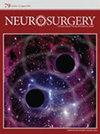了解脑动静脉畸形中血脑屏障改变的重要性及其对治疗的影响:基于动态对比增强磁共振成像的前瞻性研究。
IF 3.9
2区 医学
Q1 CLINICAL NEUROLOGY
引用次数: 0
摘要
背景和目的脑动静脉畸形(bAVM)的主要临床表现是自发性颅内出血。越来越多的实验证据证明,炎症和血脑屏障(BBB)功能障碍与疾病的临床过程和出血风险有关。我们使用动态对比增强核磁共振成像(DCE-MRI)评估了一系列脑空洞症患者(35 人)在治疗前和治疗后平均 5(±2)天的血脑屏障通透性变化。一组脑海绵畸形(CCMs)(n = 16)作为对照组,用于评估与手术相关的侧支变化。结果 在脑空洞畸形患者中,脑空洞畸形周围组织的 BBB 通透性高于其他脑实质组织(平均 Ktrans 0.145 ± 0.104 vs 0.084 ± 0.035,P = .004)。与此同时,CCM 病例的大脑周围未见明显变化(平均 Ktrans 0.055 ± 0.056 vs 0.061 ± 0.026,P = .96)。手术切除后,bAVM 周围区域的 BBB 通透性明显降低(平均 Ktrans 0.145 ± 0.104 vs 0.096 ± 0.059,P = .037)。结论根据 DCE-MRI 评估,与 CCMs 相反,bAVM 患者的 BBB 通透性在其周围实质中增加。然而,腔隙血管瘤手术切除似乎降低了韧带周围组织的 BBB 通透性。在我们的系列研究中,没有发现所谓突破现象的证据。DCE-MRI 可以成为一种有价值的工具,用于跟踪 BBB 在整个 bAVM 自然史和临床病程中的纵向损伤过程。本文章由计算机程序翻译,如有差异,请以英文原文为准。
Understanding the Importance of Blood-Brain Barrier Alterations in Brain Arteriovenous Malformations and Implications for Treatment: A Dynamic Contrast-Enhanced-MRI-Based Prospective Study.
BACKGROUND AND OBJECTIVES
The major clinical implication of brain arteriovenous malformations (bAVMs) is spontaneous intracranial hemorrhage. There is a growing body of experimental evidence proving that inflammation and blood-brain barrier (BBB) dysfunction are involved in both the clinical course of the disease and the risk of bleeding. However, how bAVM treatment affects perilesional BBB disturbances is yet unclear.
METHODS
We assessed the permeability changes of the BBB using dynamic contrast-enhanced MRI (DCE-MRI) in a series of bAVMs (n = 35), before and at a mean of 5 (±2) days after treatment. A set of cerebral cavernous malformations (CCMs) (n = 16) was used as a control group for the assessment of the surgical-related collateral changes. The extended Tofts pharmacokinetic model was used to extract permeability (Ktrans) values in the lesional, perilesional, and normal brain tissues.
RESULTS
In patients with bAVM, the permeability of BBB was higher in the perilesional of bAVM tissue compared with the rest of the brain parenchyma (mean Ktrans 0.145 ± 0.104 vs 0.084 ± 0.035, P = .004). Meanwhile, no significant changes were seen in the perilesional brain of CCM cases (mean Ktrans 0.055 ± 0.056 vs 0.061 ± 0.026, P = .96). A significant decrease in BBB permeability was evident in the perilesional area of bAVM after surgical resection (mean Ktrans 0.145 ± 0.104 vs 0.096 ± 0.059, P = .037). This benefit in BBB permeability reduction after surgery seemed to surpass the relative increase in permeability inherent to the surgical manipulation.
CONCLUSION
In contrast to CCMs, BBB permeability in patients with bAVM is increased in the perilesional parenchyma, as assessed using DCE-MRI. However, bAVM surgical resection seems to reduce BBB permeability in the perilesional tissue. No evidence of the so-called breakthrough phenomenon was detected in our series. DCE-MRI could become a valuable tool to follow the longitudinal course of BBB damage throughout the natural history and clinical course of bAVMs.
求助全文
通过发布文献求助,成功后即可免费获取论文全文。
去求助
来源期刊

Neurosurgery
医学-临床神经学
CiteScore
8.20
自引率
6.20%
发文量
898
审稿时长
2-4 weeks
期刊介绍:
Neurosurgery, the official journal of the Congress of Neurological Surgeons, publishes research on clinical and experimental neurosurgery covering the very latest developments in science, technology, and medicine. For professionals aware of the rapid pace of developments in the field, this journal is nothing short of indispensable as the most complete window on the contemporary field of neurosurgery.
Neurosurgery is the fastest-growing journal in the field, with a worldwide reputation for reliable coverage delivered with a fresh and dynamic outlook.
 求助内容:
求助内容: 应助结果提醒方式:
应助结果提醒方式:


